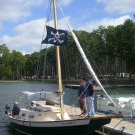
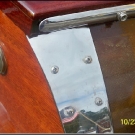
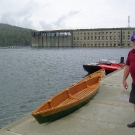
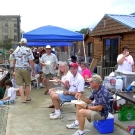
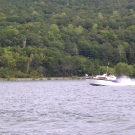
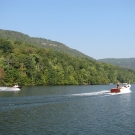
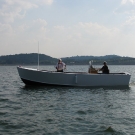
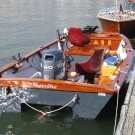
by Ken Hankinson
Although our classic mahogany runabout plans come with a resource list complied by ourselves and with feedback from our boatbuilder/customers, suppliers do come and go, and items such as planking veneers, may not be available “off-the-shelf” everywhere, let alone at the local Home Depot. Builders should also check for material sources in such magazines as WOODENBOAT, CLASSIC BOATING, BOATBUILDER, and ANTIQUE & CLASSIC BOAT TRADER. Also see the Glen-L List of Lumber Suppliers.
Other sources our builders report using for veneers include professional boatbuilders building with such materials, millworks capable of veneering, and furniture manufacturers who either may sell such veneers directly or provide a cutting service. Otherwise, you can make your own veneers by resawing from thicker solid stock, or find a sawyer capable of such work. Part of the purpose of the following article is to present still other optional ways these boats can be built.
Our mahogany runabout plans are detailed for cold molded planking methods finished off (at least on the topsides) with natural wood mahogany veneers. [There are many photos on the website showing these boats, their construction, and planking.] However, other planking options and variations are possible as I’ll discuss later. But first, an overview of our basic methods.
Although these boats are made over sawn frames crossed by various longitudinal members similar to conventional plywood hulls, sheet plywood cannot be used for planking since the hulls have reverse or compound curvatures to which sheet materials will not comply. So while the speed of application offered by sheet plywood may be lost, the methods we use (including the alternatives discussed later) are worth the extra time since they make possible the beautiful curves and contours builders look for in these boats. And such methods are well suited to the do-it-yourself builder since the skill level required is not high, and specialized equipment or woodworking techniques (such as steam bending) are not required.
You may find some runabout designs that can be built from ordinary sheet plywood that may, on the surface, appear to be of “classic” type. Yet even when finished natural, they turn out as poor imitations that just don’t look authentic in the flesh. Their typically “boxy” appearance will offend the discriminating eye of true classic boat lovers and may suffer some loss in value as a result.
COLD-MOLDED PLYWOOD CONSTRUCTION
The cold molded methods we use (often referred to as “double-diagonal” planking) consist of layers of solid wood veneers or thin plywood which has been cut into strips. Widths of strips must be narrower toward the bow, but can be progressively wider toward the stern. In fact, on some boats, aft areas on the bottom can be largely covered with sheet plywood as long as it conforms to the framing in this area. Otherwise, where curves are tight, (typically on the bottom at the bow) strip widths should be at least wide enough to receive a couple of fastenings into each end, or about 3″.
Usually, each layer is 1/8″ nominal thickness, with the number of layers and desired total thickness specified on the plans. The initial layer is installed diagonally at approximately a 45-degree angle. The second layer is then applied approximately 90-degrees to the first, with subsequent layers 90-degrees to the second, and so forth until the specified hull thickness is reached.
We are often asked how critical the thickness of each layer is; that is, how close each should be to 1/8″ net. It depends on whether solid wood veneers or plywood (which bends easier) is used, and also with the area of the hull; that is, depending on how tight the curves are. Because the tightest curves occur on the bottom forward, this is one reason why plywood may be preferred for the bottom. Another is that plywood usually costs less, and since most will paint the bottom or finish off with epoxy mixed with graphite for an unobtrusive charcoal tone, there is little reason to prefer solid wood veneers here.
In any case, builders should stick as close to 1/8″ (or 3mm) as possible. But bigger boats and those with less-severe curves may accept layers of thicker material perhaps up to 1/4″ (6mm) each. The point is not how many layers you have, but to match as closely as possible the total thickness specified, and to have at least one layer going diagonally in each direction.
On the topsides, the final layer is the appearance layer that’s critical to achieving the natural-wood finish characteristics of these boats. So to emulate solid planking, the strips are applied lengthwise here. A builder could have used plywood for all bottom and side layers up to this point. But the ideal material here is 1/8″ nominal solid wood veneer (typically mahogany, but Western red cedar and some other woods not common in the U.S. may be substituted).
Some builders substitute plywood with a mahogany finish veneer cut into “planking” strips. And while perhaps acceptable, the typically thin veneer on a 1/8″ panel won’t allow much latitude for sanding or durability in use. In any case, strips can be spiled, as will be explained later, so that there will be a near-equal number of strips fore and aft, or applied in a fixed width which may not look quite as nice depending on the boat’s curvature.
The width of topside strips has a lot to do with appearance. A range of 3″ to 4″ wide usually looks best, with 2″ a minimum and 6″ a maximum (which is a little too wide for my eye on smaller boats). And although a nominal 1/8″ thickness is recommended, such veneers may not always be available. Thus some builders have used thinner veneers, perhaps as thin as 1/32″. Besides the problem with sanding and durability mentioned above, humps, dips, and other defects are more likely to show through on such thin material. A more-practical minimum would be 1/16″.
From an appearance standpoint, plank strips should be as long as possible, with butts well staggered. However, in the case of plywood where “planks” may be no longer than the panel length (8′ typical), making butt joints less visible is harder to do, as can be joints along edges. To this end, edges can be beveled or “undercut” for a tighter “jam” fit. Also, plywood planks can be scarf-joined, but such joints may still be noticeable especially if grain patterns and coloration don’t match well from panel to panel.
Part and parcel to our method of planking, and the ultimate success and longevity of the resulting boats, is the use of epoxy resins and adhesives. In effect, every exposed surface ends up being coated with at least two coats of epoxy resin, and every joint gets bonded and glued with a similar or compatible epoxy adhesive.
We recommend final exterior hull surfaces be sheathed with a layer of fiberglass cloth for durability, reduced maintenance, and improved appearance, both topsides and bottom. When the proper cloth weight is used (4 to 7 oz), the weave of the cloth becomes virtually transparent once wetted out with resin, while the resin brings out the wood’s natural tone.
The result is a stiff, strong, stable, watertight composite wood/epoxy/fiberglass hull virtually impervious to the effects of moisture. A couple of coats of marine varnish are still recommended afterward over any epoxy coating to inhibit the affects of ultra-violet exposure.
During assembly, the initial layer is glued at all framing member and longitudinal contact points, such as along chine and keel perimeters, and intermediately to all longitudinal stiffeners. Subsequent layers are bedded in epoxy that can be thickened with silica and other additives to minimize running and sagging on more vertical surfaces.
Fastenings can be a temporary type at all points except on the final structural layer. Usually a builder can use a pneumatic gun or tool to drive staples or nails that will hold planking members in place until the glue sets. Staples can be of any suitable material including steel, stainless, bronze, or even plastic. These can be removed if not over-driven (recommended for steel staples to prevent rust stains later), or snipped off, or ground flush otherwise if bronze. For easier removal, drive through thin wax-coated plywood “washer blocks” to prevent sticking, or thick strips of plastic sheeting that remove easily once the glue sets. Use of Raptor composite fastenings eliminates the need for removal at all and are excellent for applying the final layer as the fastenings are virtually invisible and will take a stain. See the Glen-L site for details.
Note the word “structural” in the preceding paragraph as applied to the final layer. What this means is that on the topsides, if the final layer is 1/8″ or thicker veneer or plywood, we consider this a structural layer. In this case, we use flat head wood screws through all layers around hull perimeter members. These should be countersunk about 1/16″ and then plugged, resulting in an authentic-looking classic wood planking application.
If the final side layer is less than 1/8″, it becomes more like a “cosmetic” layer. Screws are still used here as final fastenings, but because of the thinner veneer, the screws won’t be doing much to hold the final thin veneer once countersunk. In other words, with thinner veneers, the epoxy does the job so be sure to use adequate glue and pressure along hull perimeters on the final layer. Plugs are still used over screws the same as before.
SOLID WOOD HULLS
In the following I’ll describe some other ways mahogany runabouts can be planked in lieu of cold molding, especially on the topsides. However, the only reasons we see to deviate from the previously described cold-molded method are:
1. The required veneers and/or plywoods are not available
2. The builder is allergic to epoxies
3. The builder wants to imitate more the planking methods used in the past for whatever reason.
It is beyond our scope to cover all the “how-to” details of the methods to be presented; these have been well covered in other boatbuilding books, such as “Boatbuilding” by Howard Chapelle, and “Boatbuilding Manual” by Robert Steward, both of which the interested reader is referred. Thus I’ll limit coverage to the pro’s and con’s of each as they apply to the size and type of boat under consideration so you can decide what’s best for you.
Even if you prefer using one of the following methods, we still feel it should be used only for the topsides; the cold molded method described previously is still preferable on the bottom for strength, light weight, low maintenance, and watertight integrity. Keep in mind that if professional wood runabout builders of the past had had the epoxy adhesives and quality plywoods and veneers available today, they would have built their boats much the way we discussed previously.
Four alternative methods are presented that use solid wood planking in one form or another, all oriented lengthwise. Yet while we feel epoxy glues are superior to most others, they are “hard-setting” products. Thus their benefits (either as adhesives or encapsulation coatings) won’t be as likely to occur due to the possible expansion and contraction of the solid wood planking that’s more likely to take place with these solid wood methods.
In other words, the nature of cold molded methods coupled with the superior bonding qualities of epoxies better equalizes or “neutralizes” wood’s tendency to “move” in much the same way that a sheet of plywood remains dimensionally stable. So depending on the method and junction, more “flexible” adhesives and elastomeric compounds may be advisable with these alternatives. Also, because of the extra planking thickness, the added protection from fiberglass sheathings may be less important or less satisfactory in use, and thus often not recommended.
Another consideration with the following methods is that they are likely to be heavier because the planking may need to be thicker compared to cold molded types due to practical matters. Also, if you are working from our plans and want to adapt to any of these methods, there may be certain changes you need to make to the framework as the plans show it – I’ll discuss such matters as they occur.
I’ve shown sections through the planking of several methods in Fig. 1 in my order of preference for emulating classic mahogany runabouts, with “A” being best showing batten seam planking. “B” shows double planking; “C” shows carvel planking; and “D” shows cove-&-bead strip planking.

BATTEN SEAM PLANKING
In the past, many v-bottom planing powerboats were built using batten seam methods. It uses longitudinal battens (much like those used in cold molding), but behind each planking seam, so there will likely be more battens than would be the case with cold molded planking, and they will be wider in order to receive plank fastenings. Battens are notched through and fastened to frames, and spaced to suit planking widths which must be determined first.
Typically planks will be “spiled”, that is, pre-shaped to fit hull contours so that there is a (more-or-less) equal number of plank ends fore and aft. While a maximum plank width of 6″ is shown and often recommended, initially the strake may likely need to be taken from much wider stock in order to conform to the hull once spiled. Yet a 6″ strake width may be too wide in these boats where planking thickness may be at a practical minimum – cupping could be a problem as a result. Hence, narrower planks may look and function better over time. All these statement in this paragraph also apply generally to the other methods following with the possible exception of strip planking.
Note that screws can be driven from the back side into the planks, or through the planking into the battens from outside. Using screws from the backside looks better outside and eliminates a lot of bungs. Round-head screws are preferable here, and washers under the heads will prevent over-driving and provide greater bearing. But the planks must be thick enough for the screws to get an adequate “grip”. In other words, 5/8″ initial thickness is probably a minimum, considering that there needs to be some leeway for material removed during sanding. Because this is thicker than what’s possible with cold molding in many designs, and along with more and wider battens, the result may be a heavier boat.
DOUBLE PLANKING
Double planking consists of two lengthwise layers of solid wood; it’s much like planking the boat twice. In the past, a layer of fabric saturated with glue or dope was typically used between layers. Today, a better choice is a generous layer of elastomeric compound. This, together with the staggered seams and tight-fitted edges should make a reasonably tight hull.
Of course, this depends on using the best combination of plank width, thickness, fastenings, and frame spacing. Usually the inner layer will be thinner than the outer mainly because the outer layer needs enough thickness to receive the inner screws as with batten seam planking, and some allowance for sanding. Like batten seam planking, round-head screws with washers are driven along the strake edges from inside.
If adapting from one of our designs, in consideration of the standard frame spacing and the fact that intermediate longitudinal stiffeners won’t be used, total planking thickness may need to be increased above that for cold molding, perhaps 3/4″ minimum. Also, additional “sister” frames may be advisable between regular frames, at least for the topsides assuming the bottom is built using cold molding. However, these intermediate frames can be lighter than normal to help counteract weight gain.
CARVEL PLANKING
Carvel planking is the typical “traditional” form of wood planking. Planking seams are usually caulked, but this is only practical when thickness is 1/2″ or more. If adapting this method to our designs, we would limit it to the topsides due to a propensity to leak when used on bottoms of higher-speed boats that may be subject to slamming loads. While perhaps less complex than batten seam or double planking, it’s not as strong in the same thickness and subject to more movement. The structure would need to be increased in much the same way as for double planking and more so, resulting in a potentially significant weight increase. But carvel planking has a certain authenticity on a wood boat; that is, for those who like the look of seams.
STRIP PLANKING
Strip planking using cove & bead seams is perhaps the most “modern” method of the four compared to cold molding. If done with care and proper plank width (not too wide), the resulting surface can be fair and smooth without any need for caulking, and maintenance will be minimal. And while not as movement-free as a cold molded hull, it’s the next most dimensionally stable. But it won’t have the traditional “planked” appearance. When left natural finished, you easily see the more-numerous strip plank seams but surfaces can be quite smooth. If painted, as some classic runabouts are, a striking craft can result assuming the decks are bright finished for contrast.
The cove & bead seams make it easy for strakes to conform to curved surfaces as they are applied. Spiling is not necessary which means it’s probably best to start planking from the sheer to the chine so shorter planks can run out lower down. Changes to framing are not necessary as long as thickness is adequate. Keeping in mind that battens aren’t used, finished thickness should be at least 5/8″ and perhaps 3/4″ on boats with greater frame spacing; strip width might be around 1″ at the edge not counting the bead height; planks that are more nearly “square” are easier to apply than wider ones.
Planks are usually edge-nailed together, with permanent screws into frames every few planks or so. For best strength all edge joints should be fully glued. As long as good-quality dimensionally-stable wood is used, hard-setting glues such as resorcinol and urea resin are acceptable, but epoxies are superior. Others suggest elastomeric compounds which may suffice but will allow more hull movement.
In any case, the combination of the cove & bead joint with edge fastening and seam adhesive results in a near-monocoque hull that’s much stronger and more dimensionally stable than the other alternatives above. And fiberglass sheathings applied with epoxy resins are acceptable and often recommended. Of course, if you want the look of mahogany, that’s what you’ll have to use. But if painted topsides are acceptable, other lighter-weight woods may be preferable. These might include various spruces, Alaskan cedar, and Douglas-fir.